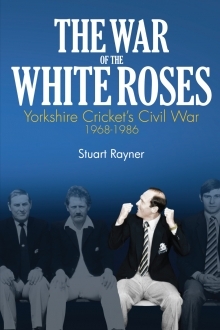The War of the White Roses
Martin Chandler |Published: 2016
Pages: 320
Author: Rayner, Stuart
Publisher: Pitch Publishing
Rating: 4 stars

There are those who find the whole thing impossible to understand, but many people care passionately about sport, and of those that do a disproportionate number inhabit the North, West and East Ridings of Yorkshire. This, Stuart Rayner’s first book, is a history of Yorkshire cricket over the period between 1968 and 1986 when the county’s internecine strife boiled over, and the club became rather more adept at washing its dirty linen in public than playing cricket, the sport at which the White Rose had been all-powerful for much of the twentieth century.
No one interested in the county game at the time will disagree with Rayner’s succinct summary of the heart of the problem, that being unashamed pride and a stubborn refusal to move with the times mixed with an arrogant belief that those spawned within their boundaries made up some sort of cricketing master race.
That fundamental issue was exacerbated by the unwieldy fashion in which the club was run. There was a large committee which was central to the administration, but there were powerful individuals as well. Then there were the giant egos that regularly clashed, immovable objects stifling innovation, and evolution rendered impossible as a result. The central and single most divisive figure throughout the era was Geoffrey Boycott, but there was a leading role too for Raymond Illingworth. Former players like Fred Trueman, Don Brennan and Ron Burnett were other men high up on a lengthy dramatis personae.
There have been many words written before about the events covered by Rayner’s book, a goodly number of them by the saga’s leading characters, but this is the first time anyone has sought to produce an entirely objective account. The book serves as a reminder to those of us who lived through the period of the remarkable behaviour of those involved. Those who are younger, and especially any who have any sort of management experience or training, will find it difficult to believe that as recently as a couple of generations ago a major organisation like Yorkshire County Cricket Club could be run so appallingly.
A few of the central characters, perhaps understandably, were not prepared to speak to Rayner, and in different circumstances that might have detracted from the book’s importance. It doesn’t much matter here though, as they had all been quoted in the past at length, and there are no gaps I can spot in Rayner’s research. Of those who did co-operate Boycott deserves particular credit for doing so fully . The contributions of the man at the eye of the storm add greatly to the book’s authority and his openness is to be respected. It would be wrong to say the passage of thirty years has mellowed him, but his account is more considered than in his own writings.
The thoughts of one of the lesser players of a previous generation, but a major figure over much of this period, Bryan Stott, were particularly illuminating. Most important of all however, in relation to the early chapters of the book at least, are the thoughts of Richard Hutton, which serve only to reinforce my hope that some day we will have the pleasure of an autobiography from him. I also enjoyed reading the thoughts of some of the young batsmen Boycott was so often accused of hampering the development of. I recall from my own observations that Martyn Moxon, Ashley Metcalfe and Kevin Sharp all looked like batsmen of the highest quality at times. None ever quite fulfilled his promise, so their stories have not been written. Their interesting and occasionally surprising contributions to The War of the White Roses are valuable ones.
Rayner’s chosen format is a chronological journey through the period, one chapter to each year. He manages the not entirely straightforward aim of allowing the participants’ passions to be given free rein whilst remaining entirely objective himself with some aplomb. As a Lancastrian I certainly started out keen to read this book, but I was surprised at just what a grip it took on my attentions. That can only be as a result of the quality of the writing which is impressive, particularly the final chapter where Rayner’s style changes slightly, as he brings an entirely fitting element of pathos with which to end his story and the playing career of Sir Geoffrey. It all but brought a tear to my eye as I closed the book, but not for long, as I looked properly at the dust jacket for the first time, and that certainly made me smile.






Nice review, Martin. I’d always thought that the period received probably its best treatment in Don Mosey’s (not exactly objective) biography of Boycott . By the sounds of it, I’ll have to get my hands on a copy of this.
Comment by Gareth Bland | 9:03pm BST 29 March 2016